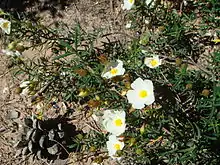| Cistus libanotis | |
|---|---|
 | |
| Scientific classification | |
| Kingdom: | Plantae |
| Clade: | Tracheophytes |
| Clade: | Angiosperms |
| Clade: | Eudicots |
| Clade: | Rosids |
| Order: | Malvales |
| Family: | Cistaceae |
| Genus: | Cistus |
| Species: | C. libanotis |
| Binomial name | |
| Cistus libanotis | |
| Synonyms[2] | |
| |
Cistus libanotis is a shrubby species of flowering plant in the family Cistaceae, with white flowers. It has been confused with Cistus clusii, which it resembles, resulting in some uncertainty in its distribution. It is endemic to the Iberian Peninsula (in southern Portugal and southwestern Spain).
Description
Cistus libanotis is a prostrate or less often erect shrub, up to 80–120 cm (2 ft 7 in – 3 ft 11 in) tall. It leaves are dark green, long and thin in shape, usually 2–4 cm (0.8–1.6 in) long by 2–5 mm (0.08–0.20 in) wide and with turned under (revolute) margins. The upper surfaces of the leaves have only a few stellate hairs, particularly on the margins and the veins; the lower surfaces have a conspicuous vein and two dense bands of short stellate hairs. The flowers are arranged in cymes or whorls, the top group forming an umbel of three or four flowers. Each flower has three striped reddish sepals, 7–9 mm (0.3–0.4 in) long by 4–5 mm (0.2–0.2 in) wide, and five white petals with a yellow spot at the base, 10–13 mm (0.4–0.5 in) long by 9–12 mm (0.4–0.5 in) wide. The stamens are unequal in length, longer than the pistil. The style is short. The fruiting capsule is 6–7 mm (0.2–0.3 in) long, with relatively large seeds up to 1.8 mm (0.07 in) in diameter.[3]
Distribution and habitat
Cistus libanotis is native to the southwestern Iberian Peninsula (southern Portugal and south-west Spain) where it is commonly found in dry, sandy coastal areas from Campo de Gibraltar to Cape St. Vincent and between Alcácer do Sal and Grândola, but it can also be found as far inland as Paradas, Seville.[4][5][6][7] There are records of this species in Morocco, Algeria and Tunisia,[5] although these may belong to Cistus libanotis auct. non L., i.e. C. clusii.[8][1]
Taxonomy
Cistus libanotis was first described by Carl Linnaeus in 1759.[2] A different but similar species, Cistus clusii, has regularly been mis-identified as this species.[4] A 2011 molecular phylogenetic study placed C. libanotis in the white and whitish pink clade of Cistus species. No strong relationship with C. clusii was found.[8]
The specific epithet libanotis was the word used for rosemary by Pliny.[9]
Phylogeny
Cistus libanotis belongs to the white and whitish pink flowered clade of Cistus species.
| Species-level cladogram of Cistus species. | ||||||||||||||||||||||||||||||||||||||||||||||||||||||||||||||||||||||||||||||||||||||||||||||||||||||||||||||
| ||||||||||||||||||||||||||||||||||||||||||||||||||||||||||||||||||||||||||||||||||||||||||||||||||||||||||||||
| Species-level cladogram of Cistus species, based on plastid and nuclear DNA sequences.[10][11][5][8] |
References
- 1 2 Rivers, M.C.; Monteiro-Henriques, T.; García Murillo, P.; Buira, A.; Fraga i Arquimbau, P.; Carapeto, A. (2017). "Cistus libanotis". IUCN Red List of Threatened Species. 2017: e.T96425363A96425962. doi:10.2305/IUCN.UK.2017-3.RLTS.T96425363A96425962.en. Retrieved 20 November 2021.
- 1 2 3 "Cistus libanotis", The Plant List, retrieved 2015-03-02
- ↑ Demoly, J.-P. & Montserrat, P. (1993), "Cistus" (PDF), in Castroviejo, S.; Aedo, C.; Cirujano, S.; Lainz, M.; Montserrat, P.; Morales, R.; Munoz Garmendia, F.; Navarro, C.; Paiva, J.; Soriano, C. & Fernandez Arias, M.I. (eds.), Flora Iberica: Plantas vasculares de la Península Ibérica e Islas Baleares (in Spanish), vol. 3, Madrid: Real Jardín Botánico, CSIC, pp. 319–337, ISBN 978-84-00-07375-6, p. 334
- 1 2 Warburg, E.F. (1968). "Cistus". In Tutin, T.G.; Heywood, V.H.; Burges, N.A.; Valentine, D.H.; Walters, S.M. & Webb, D.A. (eds.). Flora Europaea: Rosaceae to Umbelliferae. Vol. 2. Cambridge University Press. pp. 282–284. ISBN 978-0-521-06662-4.
- 1 2 3 Guzman, B.; Lledo, M.D. & Vargas, P. (2009). "Adaptive Radiation in Mediterranean Cistus (Cistaceae)". PLOS ONE. 4 (7): e6362. Bibcode:2009PLoSO...4.6362G. doi:10.1371/journal.pone.0006362. PMC 2719431. PMID 19668338.
- ↑ "Cistus" (PDF). Flora Iberica. Retrieved 24 November 2020.
- ↑ "Cistus libanotis L." Flora-on. Retrieved 24 November 2020.
- 1 2 3 Civeyrel, Laure; Leclercq, Julie; Demoly, Jean-Pierre; Agnan, Yannick; Quèbre, Nicolas; Pélissier, Céline & Otto, Thierry (2011). "Molecular systematics, character evolution, and pollen morphology of Cistus and Halimium (Cistaceae)". Plant Systematics and Evolution. 295 (1–4): 23–54. doi:10.1007/s00606-011-0458-7. S2CID 21995828.
- ↑ "Definition of libanotis". JM Latin English Dictionary. Retrieved 2015-03-19.
- ↑ Guzmán, B. & Vargas, P. (2005). "Systematics, character evolution, and biogeography of Cistus L. (Cistaceae) based on ITS, trnL-trnF, and matK sequences". Molecular Phylogenetics and Evolution. 37 (3): 644–660. doi:10.1016/j.ympev.2005.04.026. PMID 16055353.
- ↑ Guzmán, B. & Vargas, P. (2009). "Historical biogeography and character evolution of Cistaceae (Malvales) based on analysis of plastid rbcL and trnL-trnF sequences". Organisms Diversity & Evolution. 9 (2): 83–99. doi:10.1016/j.ode.2009.01.001.
External links
- Page, R.G., "Cistus libanotis L.", The Cistus & Halimium Website, archived from the original on 2015-09-23, retrieved 2015-03-19; includes photograph
